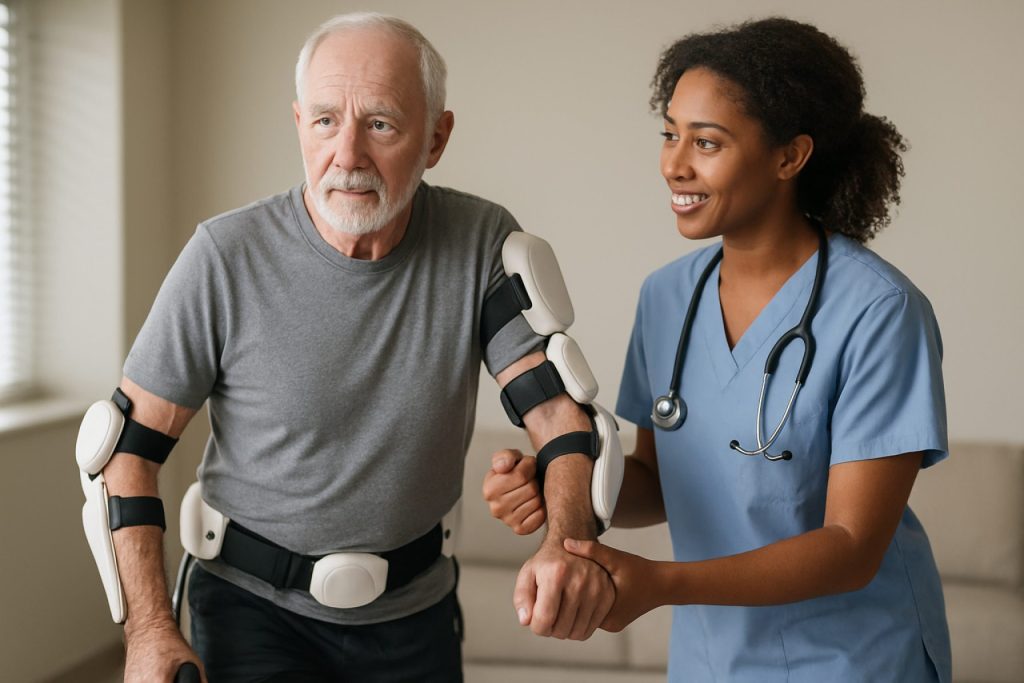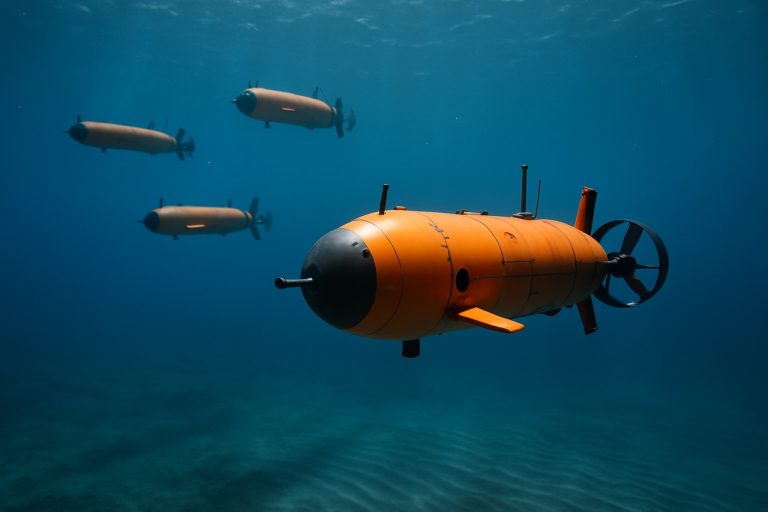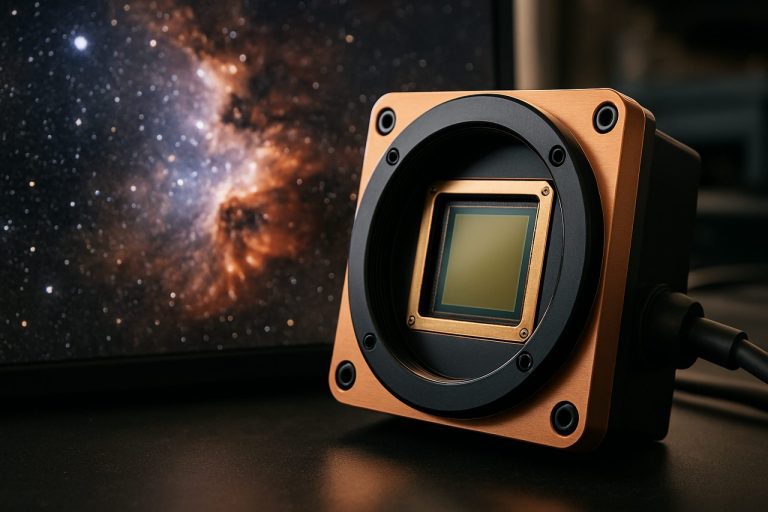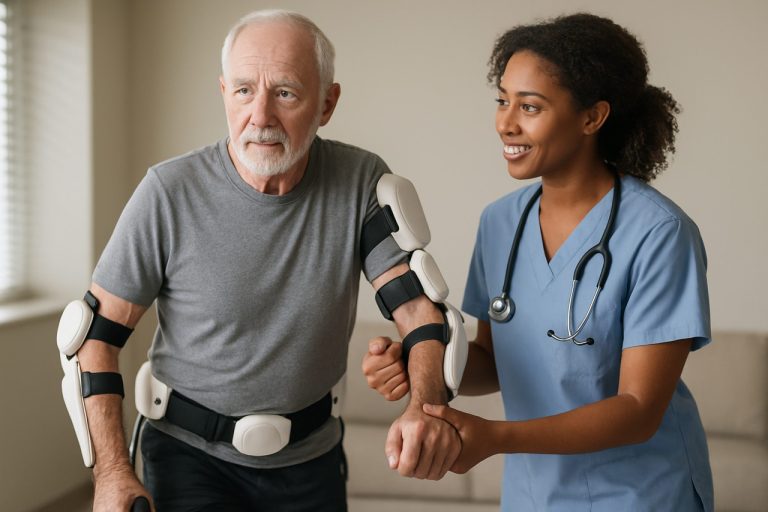
Revolutionizing Recovery: How Wearable Robotics Are Transforming Biomedical Rehabilitation in 2025 and Beyond. Explore the Market Forces, Breakthrough Technologies, and Future Pathways Shaping Patient Outcomes.
- Executive Summary: 2025 Market Landscape and Key Drivers
- Market Size, Growth Forecasts, and Regional Hotspots (2025–2030)
- Core Technologies: Exoskeletons, Soft Robotics, and Sensor Integration
- Leading Players and Innovators: Company Profiles and Strategic Moves
- Clinical Applications: Neurological, Orthopedic, and Geriatric Rehabilitation
- Regulatory Environment and Standards (e.g., FDA, ISO, IEEE)
- Integration with Digital Health: AI, IoT, and Data Analytics
- Challenges: Cost, Accessibility, and User Adoption Barriers
- Case Studies: Real-World Deployments and Patient Outcomes
- Future Outlook: Emerging Trends, R&D Pipelines, and Investment Opportunities
- Sources & References
Executive Summary: 2025 Market Landscape and Key Drivers
The wearable robotics sector for biomedical rehabilitation is poised for significant growth in 2025, driven by technological advancements, increased clinical adoption, and supportive regulatory environments. Wearable robotics—encompassing exoskeletons, powered orthoses, and assistive devices—are increasingly recognized as transformative tools for patients with mobility impairments due to stroke, spinal cord injury, or neurodegenerative diseases.
Key industry players are accelerating innovation and commercialization. Ekso Bionics, a pioneer in exoskeleton technology, continues to expand its clinical and rehabilitation product lines, with its EksoNR exoskeleton now deployed in hundreds of rehabilitation centers worldwide. ReWalk Robotics has received regulatory clearances in the US and Europe for its wearable exoskeletons, and is actively collaborating with healthcare providers to integrate these devices into standard rehabilitation protocols. CYBERDYNE Inc. from Japan, known for its HAL (Hybrid Assistive Limb) exoskeleton, is broadening its reach in Asia and Europe, focusing on both clinical and home-based rehabilitation.
Recent years have seen a surge in clinical evidence supporting the efficacy of wearable robotics. Studies published in 2023 and 2024 demonstrate improved gait, balance, and independence in patients using robotic exoskeletons as part of their rehabilitation regimen. This evidence base is prompting more hospitals and rehabilitation centers to invest in these technologies, with adoption rates expected to rise sharply through 2025.
The market landscape is also shaped by strategic partnerships and government initiatives. For example, several national health systems in Europe and Asia are piloting reimbursement schemes for robotic rehabilitation, aiming to reduce long-term care costs and improve patient outcomes. In the US, the Centers for Medicare & Medicaid Services (CMS) is reviewing coverage policies for wearable exoskeletons, which could further accelerate adoption if favorable decisions are made.
Looking ahead, the next few years will likely see further miniaturization, improved battery life, and enhanced AI-driven control systems, making wearable robotics more accessible and user-friendly. Companies such as Hocoma (a division of DIH Medical) are integrating advanced sensor technologies and cloud-based analytics to personalize therapy and track patient progress remotely.
In summary, 2025 marks a pivotal year for wearable robotics in biomedical rehabilitation, with robust growth prospects fueled by clinical validation, regulatory momentum, and ongoing technological innovation. The sector is set to play a central role in reshaping rehabilitation paradigms and improving quality of life for millions of patients worldwide.
Market Size, Growth Forecasts, and Regional Hotspots (2025–2030)
The global market for wearable robotics in biomedical rehabilitation is poised for robust growth between 2025 and 2030, driven by technological advancements, increasing prevalence of neurological and musculoskeletal disorders, and a growing aging population. The sector encompasses a range of devices, including exoskeletons, powered orthoses, and assistive robotic suits, designed to aid mobility, enhance physical therapy outcomes, and support independent living.
Key industry players are expanding their portfolios and scaling up production to meet rising demand. ReWalk Robotics, a pioneer in wearable exoskeletons for spinal cord injury and stroke rehabilitation, continues to expand its presence in North America and Europe, with ongoing clinical collaborations and regulatory approvals. Ekso Bionics is another major player, supplying exoskeletons for both clinical and industrial applications, and has reported increased adoption in rehabilitation centers across the United States and Europe. CYBERDYNE Inc., based in Japan, is notable for its HAL (Hybrid Assistive Limb) exoskeleton, which is being deployed in rehabilitation hospitals and elder care facilities throughout Asia and is expanding into Europe.
Regionally, North America and Europe remain the largest markets, supported by advanced healthcare infrastructure, favorable reimbursement policies, and active research ecosystems. The United States, in particular, is a hotspot for clinical trials and early adoption, with several Veterans Affairs hospitals and rehabilitation centers integrating wearable robotics into standard care. In Europe, Germany, France, and the UK are leading in both clinical deployment and research initiatives. Meanwhile, Asia-Pacific is emerging as a high-growth region, with Japan, South Korea, and China investing heavily in rehabilitation robotics to address demographic shifts and healthcare workforce shortages.
Recent years have seen a surge in public-private partnerships and government funding aimed at accelerating the adoption of wearable robotics. For example, Japan’s government has supported the integration of exoskeletons in elder care as part of its national strategy to address aging-related challenges. Similarly, the European Union has funded multi-country projects to validate the efficacy and cost-effectiveness of robotic rehabilitation devices.
Looking ahead to 2030, the market outlook remains highly positive. Industry leaders are focusing on improving device affordability, user comfort, and AI-driven personalization. The convergence of robotics, sensor technology, and telemedicine is expected to further expand the reach of wearable rehabilitation devices, making them accessible to a broader patient population worldwide.
Core Technologies: Exoskeletons, Soft Robotics, and Sensor Integration
Wearable robotics for biomedical rehabilitation is rapidly advancing, driven by innovations in exoskeletons, soft robotics, and sensor integration. As of 2025, these core technologies are converging to deliver more effective, adaptable, and user-friendly solutions for patients recovering from neurological injuries, musculoskeletal disorders, and age-related mobility impairments.
Exoskeletons remain at the forefront of rehabilitation robotics. Rigid, powered exoskeletons are now widely used in clinical and outpatient settings to assist gait training and upper limb rehabilitation. Companies such as Ekso Bionics and ReWalk Robotics have established FDA-cleared devices for spinal cord injury and stroke rehabilitation, with ongoing clinical trials expanding indications to multiple sclerosis and cerebral palsy. In 2025, exoskeletons are increasingly being designed for home use, with lighter frames, improved battery life, and enhanced safety features. CYBERDYNE Inc. continues to develop its HAL (Hybrid Assistive Limb) exoskeleton, which leverages bioelectrical signal detection to provide real-time, user-intent-driven assistance.
Soft robotics is emerging as a transformative approach, offering wearable devices that are lightweight, compliant, and comfortable for long-term use. These systems use soft actuators—such as pneumatic artificial muscles or shape-memory alloys—to provide gentle, adaptive support. SuitX (now part of Ottobock) and Myomo are notable for their development of soft exosuits and myoelectric orthoses, respectively, which are being adopted in both clinical and home environments. The integration of soft robotics is expected to accelerate, with new materials and fabrication techniques enabling devices that closely mimic natural muscle movement and can be customized for individual patient needs.
Sensor integration is a critical enabler for intelligent, responsive wearable robotics. Modern exoskeletons and soft robotic devices are equipped with arrays of inertial measurement units (IMUs), force sensors, electromyography (EMG) electrodes, and even biosignal interfaces. These sensors provide real-time feedback on user movement, muscle activation, and device performance, allowing for adaptive control algorithms that personalize therapy. Hocoma and BIONIK Laboratories are incorporating advanced sensor suites and cloud connectivity to enable remote monitoring, data-driven therapy adjustments, and integration with tele-rehabilitation platforms.
Looking ahead, the next few years will see further miniaturization, improved wireless connectivity, and the fusion of AI-driven analytics with sensor data, making wearable robotics more accessible and effective for a broader patient population. The convergence of exoskeletons, soft robotics, and sensor technologies is poised to redefine standards of care in biomedical rehabilitation.
Leading Players and Innovators: Company Profiles and Strategic Moves
The wearable robotics sector for biomedical rehabilitation is witnessing rapid evolution, with established leaders and agile startups driving innovation in exoskeletons, soft robotics, and sensor-integrated assistive devices. As of 2025, several companies are shaping the landscape through product launches, strategic partnerships, and global expansion.
Ekso Bionics remains a prominent force, with its EksoNR exoskeleton widely adopted in rehabilitation centers for stroke and spinal cord injury patients. In 2024, the company expanded its clinical footprint in North America and Europe, and is actively pursuing regulatory approvals in Asia. Ekso Bionics continues to invest in AI-driven gait analysis and cloud-based patient data platforms, aiming to personalize therapy and improve outcomes (Ekso Bionics).
ReWalk Robotics is another key player, known for its FDA-cleared exoskeletons for both personal and clinical use. In 2025, ReWalk is focusing on enhancing device accessibility through insurance partnerships and modular upgrades, including the integration of wearable sensors for real-time feedback. The company is also collaborating with rehabilitation networks to expand training programs for clinicians (ReWalk Robotics).
CYBERDYNE Inc., based in Japan, continues to advance its HAL (Hybrid Assistive Limb) technology, which leverages bioelectric signals to assist voluntary movement. In 2024–2025, CYBERDYNE is scaling up its international presence, particularly in Europe and the Middle East, and is investing in cloud-based remote monitoring for post-acute care (CYBERDYNE Inc.).
Ottobock, a global leader in prosthetics and orthotics, has expanded its wearable robotics portfolio with the Exopulse Mollii Suit and Paexo exoskeletons. Ottobock is leveraging its clinical network to integrate these solutions into multi-disciplinary rehabilitation programs, and is piloting AI-driven customization for spasticity management and workplace injury prevention (Ottobock).
Emerging innovators such as Wandercraft (France) and Fourier Intelligence (China/Singapore) are gaining traction. Wandercraft’s self-balancing exoskeleton, Atalante, received CE marking and is being deployed in European clinics, with U.S. trials underway. Fourier Intelligence is expanding its RehabHub ecosystem, integrating exoskeletons and rehabilitation robots with cloud analytics for personalized therapy (Wandercraft; Fourier Intelligence).
Looking ahead, the sector is expected to see increased convergence of robotics, AI, and tele-rehabilitation, with leading companies investing in interoperability, remote monitoring, and data-driven therapy optimization. Strategic alliances between device manufacturers, healthcare providers, and digital health platforms are likely to accelerate global adoption and improve patient access through 2025 and beyond.
Clinical Applications: Neurological, Orthopedic, and Geriatric Rehabilitation
Wearable robotics are rapidly transforming clinical rehabilitation, particularly in neurological, orthopedic, and geriatric domains. As of 2025, these technologies are increasingly integrated into therapy protocols, offering new hope for patients with mobility impairments due to stroke, spinal cord injury, musculoskeletal disorders, or age-related decline.
In neurological rehabilitation, exoskeletons and soft robotic suits are now routinely used to assist gait training and upper limb recovery. Devices such as the Ekso Bionics EksoNR and ReWalk Robotics exoskeletons are FDA-cleared for use in stroke and spinal cord injury rehabilitation, enabling patients to perform repetitive, task-specific movements that are critical for neuroplasticity. Clinical studies and hospital deployments in 2024 and 2025 have shown that these devices can improve walking speed, endurance, and independence in activities of daily living, with ongoing trials aiming to optimize protocols for different patient populations.
Orthopedic rehabilitation is also benefiting from wearable robotics, particularly in post-surgical recovery and joint replacement cases. Companies like CYBERDYNE Inc. have developed the HAL (Hybrid Assistive Limb) system, which detects bioelectric signals to support voluntary movement in patients recovering from orthopedic injuries or surgeries. These systems are being adopted in rehabilitation centers across Asia, Europe, and North America, with data from 2024 indicating reduced recovery times and improved functional outcomes compared to conventional therapy alone.
Geriatric rehabilitation is a growing focus, given the aging global population. Wearable robotic devices are being tailored for older adults to address frailty, balance deficits, and fall prevention. Hocoma, a subsidiary of DIH Medical, offers the Lokomat and Andago systems, which provide robotic-assisted gait training for elderly patients. These devices are now part of standard care in many rehabilitation hospitals, with recent clinical data suggesting enhanced mobility and reduced risk of secondary complications such as pressure ulcers and muscle atrophy.
Looking ahead, the next few years are expected to see further integration of artificial intelligence and real-time biofeedback into wearable robotics, enabling more personalized and adaptive rehabilitation. Major manufacturers are collaborating with healthcare providers to expand clinical evidence and refine device usability. As reimbursement pathways improve and device costs decrease, wearable robotics are poised to become a mainstay in multidisciplinary rehabilitation for neurological, orthopedic, and geriatric patients worldwide.
Regulatory Environment and Standards (e.g., FDA, ISO, IEEE)
The regulatory environment for wearable robotics in biomedical rehabilitation is rapidly evolving as these technologies become more prevalent in clinical and home settings. In 2025, regulatory agencies and standards organizations are intensifying their focus on safety, efficacy, and interoperability to ensure that wearable robotic devices—such as exoskeletons and assistive orthoses—meet rigorous requirements before reaching patients.
In the United States, the U.S. Food and Drug Administration (FDA) continues to play a central role in the oversight of wearable rehabilitation robotics. Devices are typically classified as Class II medical devices, requiring premarket notification (510(k)) or, in some cases, de novo classification. The FDA has issued guidance on clinical evaluation and risk management for robotic exoskeletons, emphasizing human factors, cybersecurity, and post-market surveillance. In 2024 and 2025, the FDA has increased engagement with manufacturers through its Digital Health Center of Excellence, supporting innovation while maintaining patient safety.
Globally, the International Organization for Standardization (ISO) and the Institute of Electrical and Electronics Engineers (IEEE) are leading efforts to harmonize standards for wearable robotics. ISO 13482:2014, which covers safety requirements for personal care robots, is being updated to address the unique challenges of wearable exoskeletons, including physical human-robot interaction and fail-safe mechanisms. The IEEE, through its Robotics and Automation Society, is developing new standards for performance metrics, interoperability, and data security in wearable medical devices, with several working groups active in 2025.
Manufacturers such as ReWalk Robotics, Ekso Bionics, and CYBERDYNE Inc. are closely involved in regulatory discussions and standards development. These companies have successfully navigated FDA and CE Mark approvals for their exoskeletons and are participating in pilot programs to streamline regulatory pathways for next-generation devices. For example, ReWalk Robotics has collaborated with regulatory bodies to expand indications for its exoskeletons, while Ekso Bionics is contributing to safety and usability standards through industry consortia.
Looking ahead, the regulatory landscape is expected to become more adaptive, with increased reliance on real-world evidence and post-market data to inform device approvals and updates. Regulatory sandboxes and expedited pathways for breakthrough devices are likely to accelerate the introduction of innovative wearable robotics, provided that manufacturers demonstrate robust safety and clinical benefit. The ongoing collaboration between regulators, standards organizations, and industry leaders will be crucial in shaping a framework that supports both innovation and patient protection in the coming years.
Integration with Digital Health: AI, IoT, and Data Analytics
The integration of wearable robotics with digital health technologies—specifically artificial intelligence (AI), the Internet of Things (IoT), and data analytics—is rapidly transforming biomedical rehabilitation in 2025. This convergence is enabling more personalized, adaptive, and data-driven rehabilitation protocols, with significant implications for patient outcomes and healthcare delivery.
Leading manufacturers are embedding advanced sensor arrays and wireless connectivity into exoskeletons and assistive devices, allowing real-time collection and transmission of biomechanical and physiological data. For example, ReWalk Robotics and Ekso Bionics have both announced new models in 2025 that feature cloud-based platforms for remote monitoring and AI-driven adjustment of device parameters. These platforms enable clinicians to track patient progress, detect anomalies, and fine-tune therapy regimens without requiring in-person visits.
AI algorithms are increasingly being used to analyze the vast datasets generated by wearable robotic devices. These systems can identify subtle trends in gait, muscle activation, and recovery trajectories, supporting predictive analytics for early intervention. CYBERDYNE Inc., a pioneer in medical exoskeletons, has integrated machine learning modules into its HAL (Hybrid Assistive Limb) systems, allowing for adaptive assistance based on real-time user performance and historical data.
IoT connectivity is also facilitating the creation of interconnected rehabilitation ecosystems. Devices from companies such as Ottobock and Hocoma can now interface with hospital electronic health records (EHRs) and telemedicine platforms, streamlining data flow between patients, therapists, and multidisciplinary care teams. This interoperability is expected to become standard practice by 2026, driven by regulatory incentives and the growing demand for remote and hybrid care models.
Looking ahead, the next few years will likely see further advances in edge computing, enabling more sophisticated AI processing directly on wearable devices, reducing latency and enhancing privacy. Industry collaborations are also underway to develop standardized data formats and secure communication protocols, as seen in initiatives led by Medtronic and other major medtech firms. These efforts aim to ensure seamless integration of wearable robotics into broader digital health infrastructures, ultimately supporting scalable, outcome-based rehabilitation.
In summary, the integration of AI, IoT, and data analytics with wearable robotics is poised to redefine biomedical rehabilitation, offering unprecedented levels of personalization, efficiency, and connectivity in patient care throughout 2025 and beyond.
Challenges: Cost, Accessibility, and User Adoption Barriers
Wearable robotics for biomedical rehabilitation, such as exoskeletons and assistive orthoses, have demonstrated significant potential in improving mobility and quality of life for individuals with neurological and musculoskeletal impairments. However, as of 2025, several persistent challenges continue to hinder widespread adoption, particularly in the areas of cost, accessibility, and user acceptance.
Cost remains a primary barrier. Advanced wearable robotic devices often incorporate sophisticated sensors, actuators, and control systems, resulting in high manufacturing and maintenance expenses. For example, leading exoskeletons from companies like ReWalk Robotics and Ekso Bionics can cost tens of thousands of dollars per unit, making them largely inaccessible to individual users and smaller rehabilitation clinics. While some manufacturers are exploring modular designs and scalable production to reduce costs, significant price reductions are not expected in the immediate future. Insurance coverage for these devices remains inconsistent, with only select models and indications being reimbursed in certain countries.
Accessibility is closely tied to cost but also involves distribution and infrastructure. Many rehabilitation centers, especially in low- and middle-income regions, lack the resources to acquire and maintain wearable robotic systems. Additionally, the need for specialized training for clinicians and users further limits deployment. Companies such as Ottobock and Hocoma are working to expand global reach through partnerships and training programs, but disparities in access persist. The urban-rural divide is particularly pronounced, with advanced rehabilitation technologies concentrated in major metropolitan hospitals.
User adoption is influenced by device usability, comfort, and perceived benefit. Early exoskeletons were often bulky and difficult to don independently, discouraging regular use. Recent models from CYBERDYNE Inc. and SuitX (now part of Ottobock) have improved ergonomics and user interfaces, but challenges remain for individuals with severe disabilities or comorbidities. Psychological factors, such as stigma or unrealistic expectations, can also impact adoption rates. Ongoing user-centered design and clinical validation are critical to addressing these issues.
Looking ahead, the next few years are expected to bring incremental improvements in affordability and usability, driven by advances in materials, battery technology, and artificial intelligence. However, overcoming the intertwined barriers of cost, accessibility, and user adoption will require coordinated efforts among manufacturers, healthcare providers, and policymakers to ensure that wearable robotics can benefit a broader population.
Case Studies: Real-World Deployments and Patient Outcomes
The deployment of wearable robotics in biomedical rehabilitation has accelerated in 2025, with several high-profile case studies demonstrating tangible patient benefits and informing future clinical practice. These real-world implementations span exoskeletons for gait training, upper limb rehabilitation devices, and soft robotic wearables, each contributing unique insights into patient outcomes and system integration.
One of the most widely cited examples is the use of the Ekso Bionics EksoNR exoskeleton in neurorehabilitation centers across North America and Europe. In 2025, multi-center studies reported that stroke and spinal cord injury patients using EksoNR during inpatient therapy achieved statistically significant improvements in walking speed and endurance compared to conventional therapy alone. These outcomes have led to expanded insurance coverage in select regions and the integration of exoskeleton-assisted gait training into standard rehabilitation protocols.
Similarly, ReWalk Robotics has continued to document the impact of its ReWalk Personal 6.0 system for individuals with lower limb paralysis. In 2025, a collaborative project between rehabilitation hospitals in Germany and Israel tracked over 100 users in home and community settings. The data showed not only improved mobility and independence but also secondary health benefits such as reduced incidence of pressure sores and improved cardiovascular health, supporting the device’s value proposition for long-term use.
Upper limb rehabilitation has also seen notable advances. Hocoma, a subsidiary of DIH Medical, has expanded the deployment of its ArmeoPower robotic arm exoskeleton in stroke recovery clinics. Case studies from clinics in Switzerland and China in 2025 highlight increased patient engagement and measurable gains in arm function, particularly when combined with virtual reality feedback. These results are influencing the design of hybrid therapy programs that blend robotics with digital therapeutics.
Soft wearable robotics, such as the ReStore Exo-Suit from BIONIK Laboratories, have been adopted in outpatient settings for post-stroke gait retraining. Early 2025 data from pilot programs in the United States indicate high patient compliance and satisfaction, with therapists noting the device’s ease of use and adaptability to different patient needs.
Looking ahead, these case studies underscore a trend toward personalized, data-driven rehabilitation, with wearable robotics enabling more intensive, task-specific therapy. As device costs decrease and clinical evidence mounts, broader adoption is expected, particularly in aging populations and regions with limited access to traditional rehabilitation resources.
Future Outlook: Emerging Trends, R&D Pipelines, and Investment Opportunities
The landscape of wearable robotics for biomedical rehabilitation is poised for significant transformation in 2025 and the coming years, driven by rapid technological advances, robust R&D pipelines, and increasing investment from both established industry leaders and innovative startups. The sector is witnessing a convergence of artificial intelligence, advanced materials, and miniaturized actuators, enabling more adaptive, lightweight, and user-friendly exoskeletons and assistive devices.
Key players such as ReWalk Robotics, a pioneer in FDA-cleared exoskeletons for spinal cord injury rehabilitation, continue to expand their product lines and clinical applications. In 2024, ReWalk received additional regulatory clearances in Europe and North America, and is expected to launch next-generation systems with enhanced mobility analytics and tele-rehabilitation features in 2025. Similarly, Ekso Bionics is advancing its EksoNR platform, focusing on stroke and acquired brain injury rehabilitation, and has announced partnerships with major rehabilitation hospital networks to integrate data-driven therapy protocols.
Asian manufacturers are also accelerating innovation. CYBERDYNE Inc. of Japan, known for its HAL (Hybrid Assistive Limb) exoskeleton, is expanding clinical trials in Europe and Asia, targeting broader indications such as neuromuscular diseases and elderly care. The company is investing in cloud-based patient monitoring and remote adjustment capabilities, reflecting a broader trend toward digital health integration.
Emerging trends include the development of soft exosuits, which use textiles and flexible actuators to provide subtle assistance for gait and upper limb rehabilitation. Companies like SuitX (now part of Ottobock) are leveraging these technologies to create devices that are less obtrusive and more suitable for daily use outside clinical settings. Ottobock, a global leader in prosthetics and orthotics, is integrating wearable robotics into its broader product ecosystem, signaling increased market convergence.
Investment activity remains robust, with venture capital and strategic corporate funding flowing into startups focused on AI-driven motion analysis, personalized therapy algorithms, and cloud-connected rehabilitation platforms. The European Union and national health agencies in the US and Asia are supporting pilot programs and reimbursement models for wearable robotics, aiming to address the growing demand for cost-effective, home-based rehabilitation solutions.
Looking ahead, the next few years are expected to bring further miniaturization, improved battery life, and seamless integration with telemedicine platforms. As clinical evidence accumulates and regulatory pathways become clearer, wearable robotics are set to become a standard component of personalized rehabilitation, offering new hope for patients with mobility impairments worldwide.
Sources & References
- Ekso Bionics
- ReWalk Robotics
- CYBERDYNE Inc.
- Hocoma
- SuitX
- Ekso Bionics
- ReWalk Robotics
- CYBERDYNE Inc.
- Ottobock
- Fourier Intelligence
- International Organization for Standardization
- Institute of Electrical and Electronics Engineers
- Medtronic



